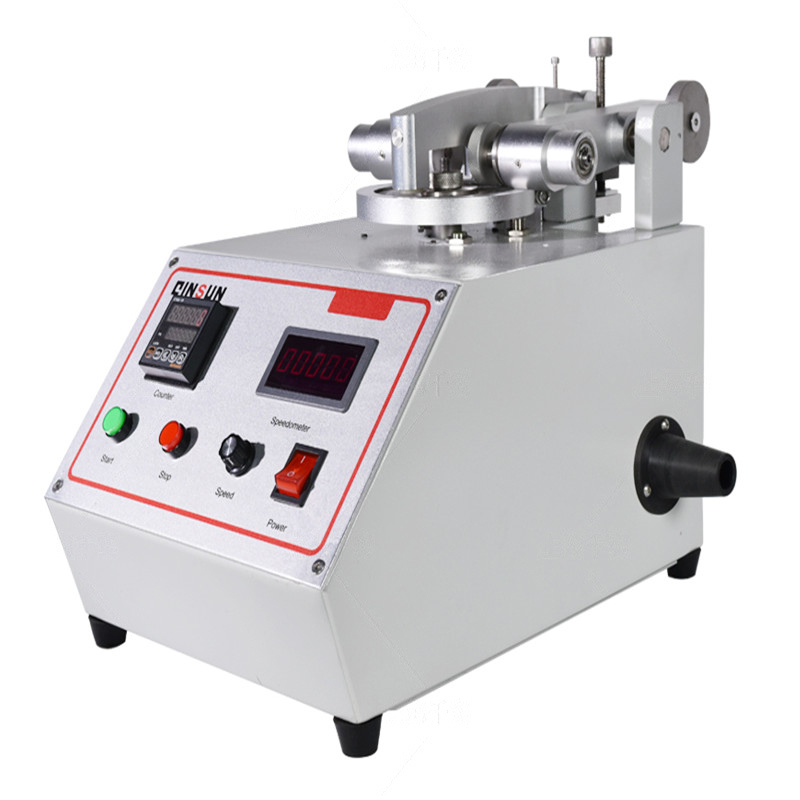Idő: Népszerűség:0idő
The TABER Wear and Abrasion Resistance Tester measures a specimen's wear resistance and other wear properties, such as mass loss, thickness loss, and light transmittance change, by subjecting it to friction with a specified abrasive material at a constant load and speed. The abrasion wheel is pre-ground using standard methods, ensuring highly consistent test results.
Before conducting the TABER abrasion test, thorough preparation is essential for ensuring test accuracy and reliability. First, prepare a specimen that meets the specified dimensions and shape, as determined by the test standard or actual requirements. Generally, standard specimen dimensions, such as Φ120 × Φ6.5 × 3 mm (diameter × inner diameter × thickness), are common, but specific dimensions may vary depending on the test standard. Ensure that the specimen surface is flat and scratch-free to eliminate any influences unrelated to the test on the results.
In addition, prepare the grinding wheel (abrasion wheel) required for the test. The material and specifications should be selected based on the properties of the test material and the test standard. For example, for leather and plastic materials used in automotive interiors, a rubber grinding wheel might be commonly used. Fine sandpaper for grinding wheel calibration and preliminary specimen preparation is also essential.
Test parameter settings are directly related to the accuracy and validity of the test results. Key parameters include load, rotational speed, test time, and the material and shape of the abrasion wheel.
1. Load: The load should be determined based on the specimen's material properties and the test standard. Common loads range from 250g to 1000g and are achieved using counterweights.
2. Speed: Speed is a key factor in controlling the wear rate. The standard speed of the TABER abrasion tester is typically 60 rpm, but this can be adjusted within a certain range depending on test requirements.
3. Test Time: The test time depends on the specimen's wear resistance and the test objective. Generally speaking, a longer test time more accurately reflects the specimen's wear resistance, but it also increases testing cost and time. Therefore, the test time should be appropriately set based on actual conditions.
4. Abrasion Wheel: The material and shape of the abrasion wheel have a direct impact on the test results. The appropriate abrasion wheel should be selected based on the test material's properties and the test standard, ensuring that it maintains a certain hardness and shape stability during the test.
1. Specimen Installation: Mount the specimen on the rotating disc, ensuring it is securely fixed and positioned correctly. Adjust the disc's speed and load to the set values.
2. Start the Test: Press the start button on the testing machine. The disc begins to rotate, the abrasion wheel contacts the specimen surface, and the wear test begins. During the test, closely observe the specimen's wear and record relevant data.
3. Mid-Test: As needed, a mid-test can be performed to assess specimen wear and adjust test parameters.
4. Stop the Test: After the set test time has elapsed, the testing machine automatically stops. At this point, turn off the power, remove the specimen and abrasive wheel, and proceed with further processing.
After the test, record specimen weight loss, dimensional change, and surface wear data according to the test standard or actual requirements. These data are important indicators for evaluating the specimen's wear resistance.
1. Weight Loss: By comparing the specimen's weight before and after the test, the specimen's weight loss can be calculated. The smaller the weight loss, the better the specimen's wear resistance.
2. Dimensional Change: By measuring the specimen's dimensional change before and after the test, you can understand the specimen's deformation during the wear process. The smaller the dimensional change, the greater the specimen's resistance to deformation.
3. Surface Wear: Observing the wear pattern and extent of the specimen's surface can assess the specimen's wear resistance. The less surface wear, the better the specimen's wear resistance.
Based on the recorded data and observed phenomena, further analysis of the specimen's wear resistance can be performed. If necessary, multiple tests can be performed to obtain more accurate and reliable results.
1. Strictly Adhere to Safety Regulations: When operating the TABER Abrasion Tester, you must strictly adhere to relevant safety regulations and operating manual requirements to ensure personal and equipment safety.
2. Accurately Set Test Parameters: Accurately setting test parameters is crucial for accurate test results. Therefore, carefully check and confirm that the test parameters are correct when setting them.
3. Keep Equipment Clean: During and after testing, dust and impurities on the testing machine and specimen surfaces should be cleaned promptly to ensure accuracy and reliability for the next test.
4. Regular maintenance: Regular maintenance of the TABER wear tester is the key to maintaining its good performance and extending its service life. Regular inspection and maintenance should be carried out in accordance with the requirements of the equipment maintenance manual.
Vállalati telefon
+86-21-6420 0566
munkaidő
Hétfőtől péntekig
Mobiltelefon:
13816217984
E-mail:
info@qinsun-lab.com
